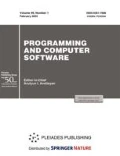Abstract
Automated approaches to the choice and tuning of image analysis algorithms for solving a particular problem are considered. A new automated method for the construction of near-optimal object identification procedures is described. The objects to be identified can belong to several classes. The identification is based on reference images of those objects and uses a learning sample of images. The construction of the desired procedure assumes that it is selected from a set of procedures detecting the given object. This set is formed by the reference image of the object and uses algorithms of certain predefined types. The selection procedure is based on a genetic algorithm described in the paper.
Similar content being viewed by others
REFERENCES
Duda, R.O. and Hart, P.E., Pattern Classification and Scene Analysis, New York: Wiley, 1973. Translated under the title Raspoznavanie obrazov i analiz scen Moscow: Mir, 1986.
Marr, D., Vision: A Computational Investigation into the Human Representation and Processing of Visual Information, San Francisco: Freeman, 1982. Translated under the title Zrenie: informatsionnyi podkhod k izucheniyu predstavleniya i obrabotke zritel'nykh obrazov, Moscow: Radio i Svyaz', 1987.
Haralick, R. and Shapiro, L., Computer and Robot Vision, vol. 1, Reading, Mass.: Addison-Wesley, 1992.
Haralick, R. and Shapiro, L., Computer and Robot Vision, vol. 2, Reading, Mass.: Addison-Wesley, 1992.
Forsyth, D.A. and Ponce, J., Computer Vision: A Modern Approach, New York: Prentice Hall, 2002.
Pope, A.R. and Lowe, D.G., Learning Object Recognition Models from Images, Proc. 4th Int. Conf. on Computer Vision, Berlin: IEEE, 1993.
Pope, A.R., Model-Based Object Recognition. A Survey of Recent Research, Technical Report, 1994, no. 94-04.
Buryak, D.Yu. and Vizil'ter, Yu.V., Automated Construction of Near-Optimal Procedures for Object Identification and Detection in Images Based on Genetic Algorithms, 12th Int. Conf. on Computer Graphics and Machine Vision GRAFICON-2002, Nizhnii Novgorod, 2002.
Buryak, D.Yu. and Vizil'ter, Yu.V., Application of Genetic Algorithms to Automated Construction of Image Analysis Procedures, 6th Int. Conf. on Pattern Recognition and Image Analysis: New Information Technologies (ROAI-6-2002), Novgorod, 2002, pp. 87-92.
Buryak, D.Yu. and Vizil'ter, Yu.V., A Method for Automated Construction of Object Identification Procedures in Digital Images, Programmnye sistemy i instrumenty (Software Systems and Tools), Korolev, L.N., Ed., Thematic issue of the Department of Computational Mathematics and Cybernetics, Moscow State University, 2002, no. 3, pp. 107-120.
Author information
Authors and Affiliations
Rights and permissions
About this article
Cite this article
Buryak, D.Y., Vizil'ter, Y.V. Automated Construction of Identification Procedures for Objects Belonging to Several Classes. Programming and Computer Software 29, 239–244 (2003). https://doi.org/10.1023/A:1025736923630
Issue Date:
DOI: https://doi.org/10.1023/A:1025736923630




